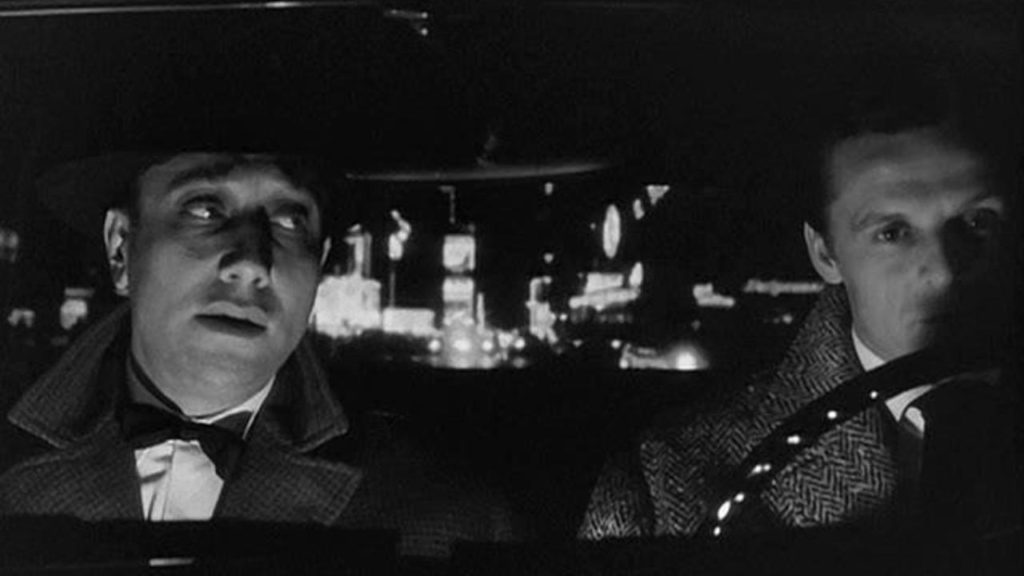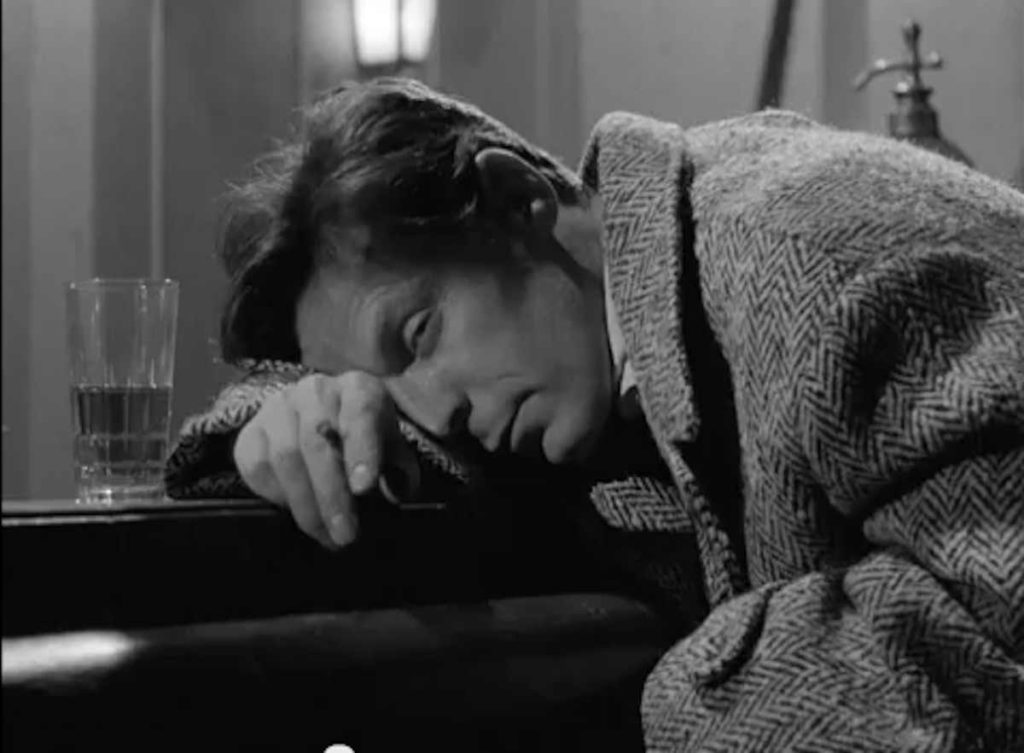A French Director’s Vision of America
DIRECTOR; Jean-Pierre Melville/French/1959
“Whenever Americans are looking for a man, they keep three words in mind… ‘Cherchez la femme’.”
 A sundown-to-sunup search across Greater Manhattan for a missing French delegate to the UN by a French journalist, Moreau (director Jean-Pierre Melville), and a tabloid photographer, Delmas (Pierre Grasset), becomes a deeper quest concerning issues of professionalism, national identity, and morality. At 85-minutes, director Melville’s lean, taut thriller (and more on this in a bit) plays like an especially frank and measured variation on American crime thrillers of the period. Retroactively given the name film noir by French film critics, the term for the dark, shadowy melodramas popular throughout the 1940s and 50s gained cultural currency contemporary to the film’s release (in 1959) just as the pessimistic post-war mood the genre described was waning and giving way to a time of greater optimism and hope for the future (unintentionally highlighted by a montage of magazine covers toward the end of the picture, one of which contains the headline “Democratic Forecast: A Catholic in 1960”). Unsuccessful in its original French run, and never released theatrically in the United States, Jean-Pierre Melville’s Two Men in Manhattan is simultaneously a conventionally-entertaining genre picture and an unconventionally-subversive art film.
A sundown-to-sunup search across Greater Manhattan for a missing French delegate to the UN by a French journalist, Moreau (director Jean-Pierre Melville), and a tabloid photographer, Delmas (Pierre Grasset), becomes a deeper quest concerning issues of professionalism, national identity, and morality. At 85-minutes, director Melville’s lean, taut thriller (and more on this in a bit) plays like an especially frank and measured variation on American crime thrillers of the period. Retroactively given the name film noir by French film critics, the term for the dark, shadowy melodramas popular throughout the 1940s and 50s gained cultural currency contemporary to the film’s release (in 1959) just as the pessimistic post-war mood the genre described was waning and giving way to a time of greater optimism and hope for the future (unintentionally highlighted by a montage of magazine covers toward the end of the picture, one of which contains the headline “Democratic Forecast: A Catholic in 1960”). Unsuccessful in its original French run, and never released theatrically in the United States, Jean-Pierre Melville’s Two Men in Manhattan is simultaneously a conventionally-entertaining genre picture and an unconventionally-subversive art film.
Opening on a multi-ethnic group of small children playing beneath the Manhattan Bridge (the location where the film also ends), the film quickly moves to on-location footage of, in succession, the United Nations Building, Rockefeller Plaza, and Times Square before, as the story proper begins, descending into squalid apartment buildings, an off-Broadway theater, seedy bars, a not-so-seedy bordello, a strip-joint, and an all-night hospital. With style and atmosphere to spare, the nighttime Manhattan locations, coupled with realistic and authentic-feeling interiors recreated in Paris sound-stages, gives the production a documentary-like vibe that effectively underscores the moral ambiguity of the film’s race through a city’s midnight soul. Armed only with three tabloid pictorial ‘leads’ – showing the married French delegate photographed with a succession of unidentified women, which include an actress, a jazz singer, and a stripper – the honor-bound journalist, Moreau, and his anything-for-a-story photographer colleague, Delmas, chase up and down the numbered, crisscrossing streets of the downtown area – a series of literal and metaphorical ‘blind alleys’, which also include the diplomat’s secretary and a high-class prostitute – before arriving at the “truth” in one of the aforementioned womens’ apartment. Yes, there are women, several of them in fact, and the central conflict of the film, and between the Two Men, becomes what should or should not be splashed across tomorrow morning’s front page to be read by the French delegate’s unsuspecting wife and pursuing daughter (Christian Eaudes).
And therein lies the crux of the film: for a genre picture that so successfully evokes the stylish atmosphere of the American crime thriller, the actual criminality of the proceedings is far-removed from the usual blood-soaked, violence-permeated goings-on of your standard, boilerplate noir. Rather, Moreau and Delmas are embroiled in subterfuge, morally-questionable tactics, and outright lies — including falsifying their credentials, forcing entry to private residences, and, in one scene, posing as relatives to a woman who has just attempted suicide — in order to achieve their aims. Director Melville as Moreau, who with his trench coat, fedora, cool demeanor, and dark-hooded sleepy eyes resembles a cross between Humphrey Bogart and Robert Mitchum, and actor Grasset as Delmas, who with his matinee good-looks and snake-like, silky charms — in one creepy/memorable scene he gleefully snaps a cheesecake shot of the stripper as she disrobes behind a curtain — suggests an ever-so-slightly seamier version of Burt Lancaster or Kirk Douglas; both initially appear to represent opposite ends of the “honor scale” — with Moreau espousing traditionally-French journalistic integrity and Demas reflecting the new-found, Americanized hunger for scandal-making — but, by film’s end, neither figure is as clear-cut or morally-compromised (or uncompromised) as each is first presented.

Complicating these matters, as revealed by two of Moreau’s superiors — and a fact well-known to Moreau and Demas — the philandering French diplomat was a great leader of the Resistance (those familiar with director Melville’s biography and body of work may know that Melville himself fought with the Resistance and later made his masterpiece about their efforts, 1969’s Army of Shadows); all involved are aware that a post-World War II society needed its heroes above everything else. True, the film might address these complicated issues implicitly throughout, but nowhere more forcefully than in the climactic scene of Moreau and Delmas arguing in full-hardboiled, tough-talking mode on the roof of the actress’s apartment building about this very question — the Manhattan skyline twinkling darkly in the background. Here, the intensity of the scene is equal to scenes in similar noirs which might have included gunplay or violent betrayal. Coupled with the larger issues these Two Men in Manhattan enact regarding nationalism, professional ethics, and morality (or its lack), the genre trappings of fast-paced pursuit, stylish atmospherics, and stunning location footage provide a dramatic backdrop that actually foreground the problems the film address.
In other words, it took an America-loving Frenchman with an appreciative eye for Night and the City — the title of Jules Dassin’s 1950 noir thriller, which likewise concerns a foreigner’s view of an alien city — to match style and theme so seamlessly. As the film ends, the sun rises beneath the bridge upon which the film opened, and the shifting alliances between pursued and pursuer resolve according to a morally-compromising roll of film shoved between the grates of an open sewer, the jazzy piano score (yet unmentioned, but greatly adding to the film’s tone and mood) likewise resolves to diminishing notes describing steel-gray dawn. Indeed, the ambiguity of the film’s tone and style – neither black nor white, but gray – might account in part for its lack of success in France and lack of distribution in the United States. Not a film that any American director could have made, this is America as described by a uniquely French vision that simultaneously celebrates and subverts a uniquely American genre.


